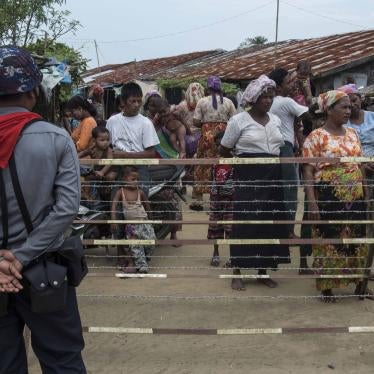I stood at the edge of the Naf River on the Bangladesh border watching heavy smoke rise from a village on the Burma side. Bangladeshi border guards talked of fires all along the border targeting villages of Rohingya Muslims.
The fear was palpable among those I met who have recently escaped into Bangladesh. In fact, hundreds upon hundreds have been pouring across every border crossing. In the 20 minutes I was at just one of the many Naf crossings, I counted several hundred people enter Bangladesh – from mothers with babies to the elderly and infirm. One young man said that he feared a further violent crackdown: “Now all we have are empty villages without even the men. We sent our women and children out, but now we had to leave as well.”
New satellite data obtained and analyzed by Human Rights Watch show widespread burnings in northern parts of Burma’s Rakhine state.
Terrified Rohingya who have arrived in Bangladesh said that Burmese soldiers, police, and ethnic Rakhine mobs had carried out armed attacks on villagers and burned down their homes. In Bangladesh, I met many in the overcrowded Cox’s Bazar hospital suffering from bullet and shrapnel wounds.
United Nations officials estimate that more than 70,000 have crossed into Bangladesh since Burmese forces began operations against Rohingya villages following after a series of coordinated attacks by Rohingya militants in late August. The Arakan Rohingya Salvation Army (ARSA) reportedly attacked at least two dozen police posts and checkpoints and a military base. The government reported that 11 security force members and many alleged militants had died. There are reports that hundreds of villagers have since been killed in the government operations.
The Burmese government says that it is ARSA militants and Rohingya villagers who are burning villages, but has not provided any evidence to support these allegations. After similar allegations during the burning of Rohingya areas between October 2016 and December 2016, Human Rights Watch and others determined that Burmese security forces deliberately set those fires.
In the Bangladesh border area, the recently arrived Rohingya seek space wherever they can find it – on roadsides, hill slopes, and market towns. Grateful to have escaped, they worry about family members still in Burma.
Humanitarian supplies are scarce. Aid workers say the available high-energy biscuits won’t cover the new arrivals. Thousands of children also need schooling and the youngest will need vaccines.
The tragedy facing the Rohingya is multifaceted, and will require tremendous resolve to remedy. It demands the world’s attention, and fast.











